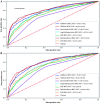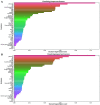Prediction of Acute Kidney Injury After Cardiac Surgery Using Interpretable Machine Learning
- PMID: 36937087
- PMCID: PMC10016126
- DOI: 10.5812/aapm-127140
Prediction of Acute Kidney Injury After Cardiac Surgery Using Interpretable Machine Learning
Abstract
Background: Acute kidney injury (AKI) is a complication that occurs for various reasons after surgery, especially cardiac surgery. This complication can lead to a prolonged treatment process, increased costs, and sometimes death. Prediction of postoperative AKI can help anesthesiologists to implement preventive and early treatment strategies to reduce the risk of AKI.
Objectives: This study tries to predict postoperative AKI using interpretable machine learning models.
Methods: For this study, the information of 1435 patients was collected from multiple centers. The gathered data are in six categories: demographic characteristics and type of surgery, past medical history (PMH), drug history (DH), laboratory information, anesthesia and surgery information, and postoperative variables. Machine learning methods, including support vector machine (SVM), multilayer perceptron (MLP), decision tree (DT), random forest (RF), logistic regression, XGBoost, and AdaBoost, were used to predict postoperative AKI. Local interpretable model-agnostic explanations (LIME) and the Shapley methods were then leveraged to check the interpretability of models.
Results: Comparing the area under the curves (AUCs) obtained for different machine learning models show that the RF and XGBoost methods with values of 0.81 and 0.80 best predict postoperative AKI. The interpretations obtained for the machine learning models show that creatinine (Cr), cardiopulmonary bypass time (CPB time), blood sugar (BS), and albumin (Alb) have the most significant impact on predictions.
Conclusions: The treatment team can be informed about the possibility of postoperative AKI before cardiac surgery using machine learning models such as RF and XGBoost and adjust the treatment procedure accordingly. Interpretability of predictions for each patient ensures the validity of obtained predictions.
Keywords: AKI Prediction; Acute Kidney Injury; Cardiac Surgery; Interpretable Machine Learning.
Copyright © 2022, Author(s).
Conflict of interest statement
Conflict of Interests: The authors declare no competing interests.
Figures





References
LinkOut - more resources
Full Text Sources
Research Materials
Miscellaneous
